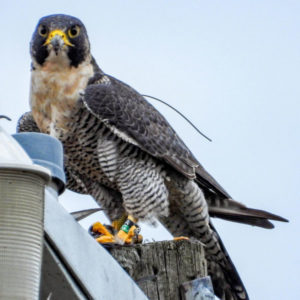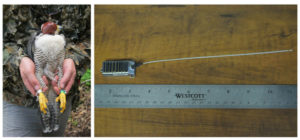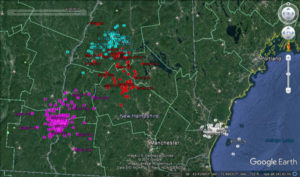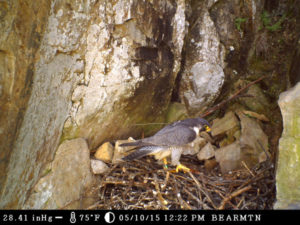(by Chris Martin)
On January 19, 2022, Pocono Wildlife Rehabilitation and Education Center in Stroudsburg, PA admitted for care an underweight female Peregrine Falcon that was wearing coded leg bands and a weathered backpack-style transmitter. The Center’s Director Katherine Uhler said the bird had been found grounded early that morning in nearby Northampton County. After a few emails back and forth to Kathy, and Chris DeSorbo from Biodiversity Research Institute (BRI), we quickly confirmed that this bird was ‘Black/Green A/G,’ a NH breeding female Peregrine that we had been tracking for almost 8 years!

‘A/G’ was initially caught in May 2014 at her Bear Mountain nest by Newfound Lake in Hebron. At that time, a field crew from BRI, NH Audubon, and Stantec Inc. fitted her with leg bands and a 11-gram satellite tracking device known as a PTT. Since she was an adult-plumage bird at capture, we assumed that she had hatched in 2012 or before, making her now (in 2022) at least 10 years old. Both PTT data and traditional field observations confirmed that she nested at Bear Mountain in Hebron from 2014 through 2017 and fledged 5 young in those 4 years. Then she moved 20 miles west to another breeding territory at Holts Ledge in Lyme, where she raised an additional 3 young from 2018 through 2021.

(Right) 11-gram satellite transmitters like this one were deployed on 5 New Hampshire female Peregrines from 2014-2017, photo by Chris Persico, BRI.
‘A/G’ was the first one of 5 adult female falcons that our research team captured on NH nests between 2014 and 2017. We wanted to learn about Peregrine breeding home ranges, identify migratory pathways, and find out where these birds overwintered. This small group of tracked falcons provided us with some fascinating data (for full details, see this BRI web page). Two females overwintered annually in different parts of eastern PA, one migrated to coastal CT, and one remained year-round on her Portsmouth-area breeding territory. One more bird unexpectedly traveled north to Quebec and back during her late Summer post-breeding period, but we lost contact with her by November and never learned where she might have overwintered.

Location data from ‘A/G’ showed that she traveled to a particular area east of Allentown, PA, each October, returning to NH again in early March. Oddly, one year she made her return north in February, but then turned right around and headed back to her PA wintering area, where she waited to return north a second time in early March. Must have been just too cold up here!
About 2 years ago, signals from ‘A/G’ became very irregular. We knew she was still alive because she was photographed multiple times in Boscawen in Sep-Oct 2020 and in Aug-Oct 2021, prior to her usual Fall migration. She was quite recognizable due to her color bands and the transmitter and antenna on her back. The team had been planning to recapture her in Spring 2022 to remove the malfunctioning device. But just over 7.5 years after our team first handled her, ‘A/G’ was admitted to the Pocono Clinic. Her transmitter was worn or damaged and BRI’s Chris asked Kathy to remove it by cutting the soft ribbon harness that held it in place.

Since being admitted to rehab at the Ponono Clinic last month, ‘A/G’ has been eating well; her weight increased from 760 grams to >900 grams in just the first 2 weeks of care. She has been on medications to fight bacterial infection and improve her liver function. We are hopeful that her next blood test will show a decreased white blood cell count, and that she will be healthy enough for release in time to make her usual early March journey back to the Granite State for the 2022 breeding season.
Best wishes and bon voyage, A/G!
